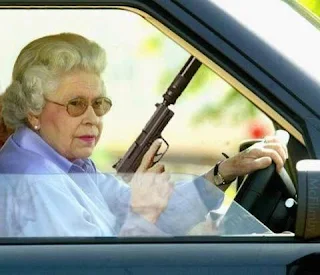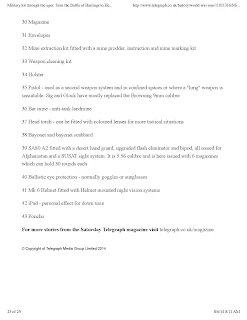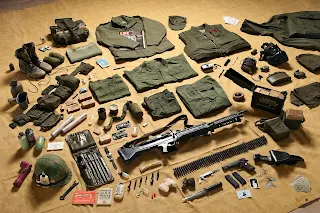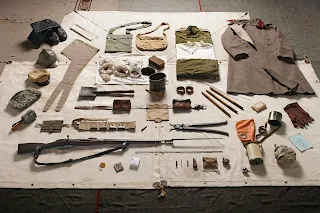When one thinks of a bespoken firearm, names like Boss & Co., Holland & Holland, Purdy and Rigby, and shotguns, normally come to mind, particularly for the King of Great Britain. But that would not be the case with King George VI during World War II. An entirely different gun once which belonged to George VI, now resides in the Imperial War Museum. It is in a suitably inconspicuous wooden cased (attache type), and is a STEN Mk II 9mm Machine Carbine, with three fully loaded magazines, and additional ammunition in the nine boxed compartments to the left part of the case (estimated 450 rounds). Unlike the normal production cost $10.00 USD configuration it has an extremely well finished exterior surface, and I feel certain precisely toleranced interior parts, specifically the magazine followers and feed lips. There is a question as to how frequently either he personally, or his equerry, carried the cased weapon during the entire World War II. (Editorial note: Perhaps the recommendations of certain current leaders should be reviewed in the context of the King's choice. He gave both Elizabeth and Margeret shooting instruction, Elizabeth learning at the age of 14, on a Thompson .45cal. Model 1921 Sub-Machine Gun, which purportedly belonged to Prime Minster Winston Churchill).
Wednesday, October 25, 2023
A Different Kind of Bespoken Gun for a King at War
Monday, October 9, 2023
Kitting the British Tommy through the Ages
In 2014, The Telegraph published a pictorial series showing the kit of a British soldier at various times throughout modern history from The Battle of Hastings to Helmand Province. The actual work was done by well known London based photographer, Thom Atkinson. This author believes that this series merits being re-shown as a definitive reference for military historians, artists, toy soldier, and military miniature collectors. A few of the numerically annotated images were inadvertently cropped, and in one case the image and text (The Alma 1854) were completely omitted. Where possible these have been augmented with full images. Each image can be enlarged by double tapping your mouse.With full acknowledgement and gratitude to the Telegraph and Thom Atkinson, the full series is again presented herein.
Reconnaissance Soldier, 2nd Battalion Royal Anglian Regiment ‘The Poachers’, Exercise Steadfast Defender, 2024
This belongs to a soldier who had his bag packed and was ready to ship off to Poland as part of a Nato exercise A drone, camera and heat map are essential for a reconnaissance soldier. The weapon is a very precise rifle with long-range sight. A Ghillie suit (centre, above the protective vest) acts as camouflage for undercover reccies on the front line.
Ukrainian recruit, Operation Interflex UK-led training, 2024
This brand new kit comes from all over the world, supplied by countries supporting Ukraine – all survival and protection gear, no weapons. It includes a minesweeping kit, entrenching tools, waterproof boots for snow, heavy duty boots for trenches, and trainers. Plus a Ukrainian translation of a book about the Spartans.
Union Army 2nd Sergeant, Battle of Gettysburg, 1863
The American Civil War was a precursor to the First World War; both involved trench fighting and the use of bayonets, such as the one pictured here. Regardless of the country, in the West, says Atkinson, issued kit tend to be very similar. Likewise the creature comforts.
Blackfoot Horse Raider, Montana, 1875
The colourful, decorative nature of this kit belies the fact that it contains the same essentials: food and a way to cook it; tools like a knife or scissors; and warmth with the blankets and furs.
German Private Soldier, Battle of the Somme, 1916
The First World War started with soldiers riding horses and carrying lances, and ended with tanks, artillery and trench warfare. This German uniform is from the latter end of the conflict and contains, says Atkinson, ‘the ghost of the Second World War in there as well – a lot of things stayed the same.’
US Army Paratrooper, Operation Market Garden, 1944
A paratrooper had much more kit than any other soldier, because they were being dropped behind the lines, where they had to survive for longer. ‘You’d get a whole bag strapped to your legs… full of stuff to carry you through a few days.’ The kit here straddles the old and the new: a wooden rifle, but also knuckledusters and grenades.
Close Support Sapper, Royal Engineers, Helmand Province, 2014
No reproduction material here: this is genuine British Army kit. The metal detector would have been used for minesweeping; there are also explosives. Sandals were issued kit; soldiers might have needed to run for cover even when they were showering.
US Marine Machine Gunner, Battle of Hue City, 1968
Weaponry had started to develop by the Vietnam War, with rapid firing weapons like this automatic machine gun. Atkinson adds: ‘I like the camera, because it seems that Vietnam was the first war where you could see it – it was the war of the photojournalist.”
Mladshi Unteroficier, 1st Russian Women’s Battalion of Death, Kerensky Offensive, 1917
‘War is so associated with men in our minds – I find it really moving [to see a woman’s kit]’, says Atkinson. This Russian woman’s uniform, however, is virtually identical to what her male counterpart would have received.











































